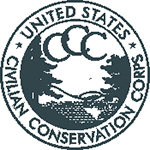History of Whipple Dam State Park
The park area was originally purchased from the Iroquois Confederation by the Proprietary Government of Pennsylvania on July 6, 1754. The land eventually became part of the Monroe Iron Works, a few miles to the north.
Charcoal was produced in the area for use in the iron furnace, and there is some evidence of iron ore mining. During 1868, Osgood M. Whipple purchased a large block of land and constructed a dam and sawmill near the current park dam. The purpose of the dam was to supply a source of water for the operation of an “up and down” sawmill. Whipple left the lumber business in 1897, but the dam remained for many years and was known locally as “Whipple’s Dam.”
During 1927, the Department of Forests and Waters was considering a recreation site in the area and surveyed the old log-crib dam. It was decided to construct a new dam upstream at a better location. The new dam was completed during the spring of 1928 and provided a shallow pool.
Recreational activities began almost immediately and by the early 1930s, Whipple Dam was listed as a State Forest Public Camp. During 1928, a camp for Boy and Girl scouts opened on the north side of the lake. The camp closed during 1941.
Civilian Conservation Corps

Between 1933 and 1941, the Civilian Conservation Corps (CCC) had a work camp at Owls Gap (S-60-PA), east of the park. The corps members built pavilions, roads, beach, and restrooms during this period.
During 1935, the CCC dismantled the old dam and constructed the existing dam and bridge.
During 1987, the 32-acre park day-use area was designated the Whipple Dam National Historic District. This entry on the National Register of Historic Places recognizes, protects, and preserves the work site of one of the Depression-Era's most important relief programs -- the CCC.
The CCC work was performed to guidelines embraced by the National Park Service. The use of native materials and the rustic look exemplify the idea that parks should harmonize with the natural setting and not be glaring intrusions onto the landscape.
Today, all construction and repair work is done to complement the design character of the CCC architecture and construction methods.